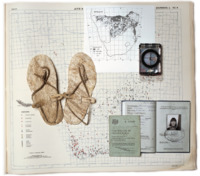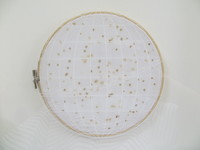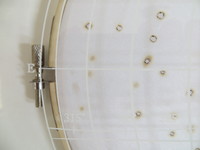Items
Site
The Medicine Chest
keywords is exactly
movement
-

Page 175 of the Curiosity CLXXV catalogue
"The page presents a curated collection of images: a map from the Avian Demography Unit illustrating the distribution of the bataleur Terathopius ecaudatus along the political border, though the bateleur is more frequently found where there is no formal farming; a Ngwato child’s oxhide sandals collected by Isaac Schapera (a British social anthropologist who worked in South Africa and Botswana); a compass; the identification documents of Paula Ensor (previous dean and Professor of Education), who spent time in exile in Botswana; and a Certificate of Registration necessary for movement across borders, all of which are overlaid on top of a large map from the Afrikaans Atlas provided by Rajend Mesthrie of the Department of Linguistics and Southern African Languages that shows the Afrikaans language’s distribution. Contextualising all of these objects in relation to the large map cuts across disciplinary boundaries and illustrates the scope and impact of the colonial and apartheid regimes and their influence on immigration laws, language studies, ornithology and anthropology" (Liebenberg 2021: 193). -

Deductions from smooth rocks
Extract from Bettie Higgs's reading of rocks in 'Visual Practices Across the University'. Most of the rocks in this photograph are about 360 million years old, so the grains that comprise them are substantially older. The grains came originally from a mountain range, as large as the Himalayas, whose roots can still be seen in counties Mayo and Donegal, in the northwest of Ireland. The grains were carried south by rivers and deposited in this area; the smallest grains were carried all the way to the ocean, which was far south of Cork at the time, in what is now the Atlantic Ocean south of Ireland. (There was very little rainfall at the time: the portion of land that is now Cork was 10° south of the Equator. This can be deduced from the properties of the iron in the rock.) The water in which the grains were transported was oxygenated, and the iron precipitated out as iron oxide (haematite), which cemented the grains and which accounts for the red color (Elkins 2007: 74 - 78). -

Amelia
"We are on the line 157 337. We will repeat this message. We will repeat this on 6210 kilocycles. Wait." On July 2, 1937 Model 10 Electra 1055 piloted by Amelia Earhart with navigator Fred Noonan took off from Lae Airfield, New Guinea and was never seen again. Earhart's last radio message was estimated to be within 200 miles of her destination Howland Island. Burn holes made with a magnifying glass on a handkerchief which corresponds to the positioning of the stars as observed from the place, date and time Amelia Earhart sent her last broadcast. -

Amelia (detail)
"We are on the line 157 337. We will repeat this message. We will repeat this on 6210 kilocycles. Wait." On July 2, 1937 Model 10 Electra 1055 piloted by Amelia Earhart with navigator Fred Noonan took off from Lae Airfield, New Guinea and was never seen again. Earhart's last radio message was estimated to be within 200 miles of her destination Howland Island. Burn holes made with a magnifying glass on a handkerchief which corresponds to the positioning of the stars as observed from the place, date and time Amelia Earhart sent her last broadcast. -

The Curious Case Of Benjamin Button


